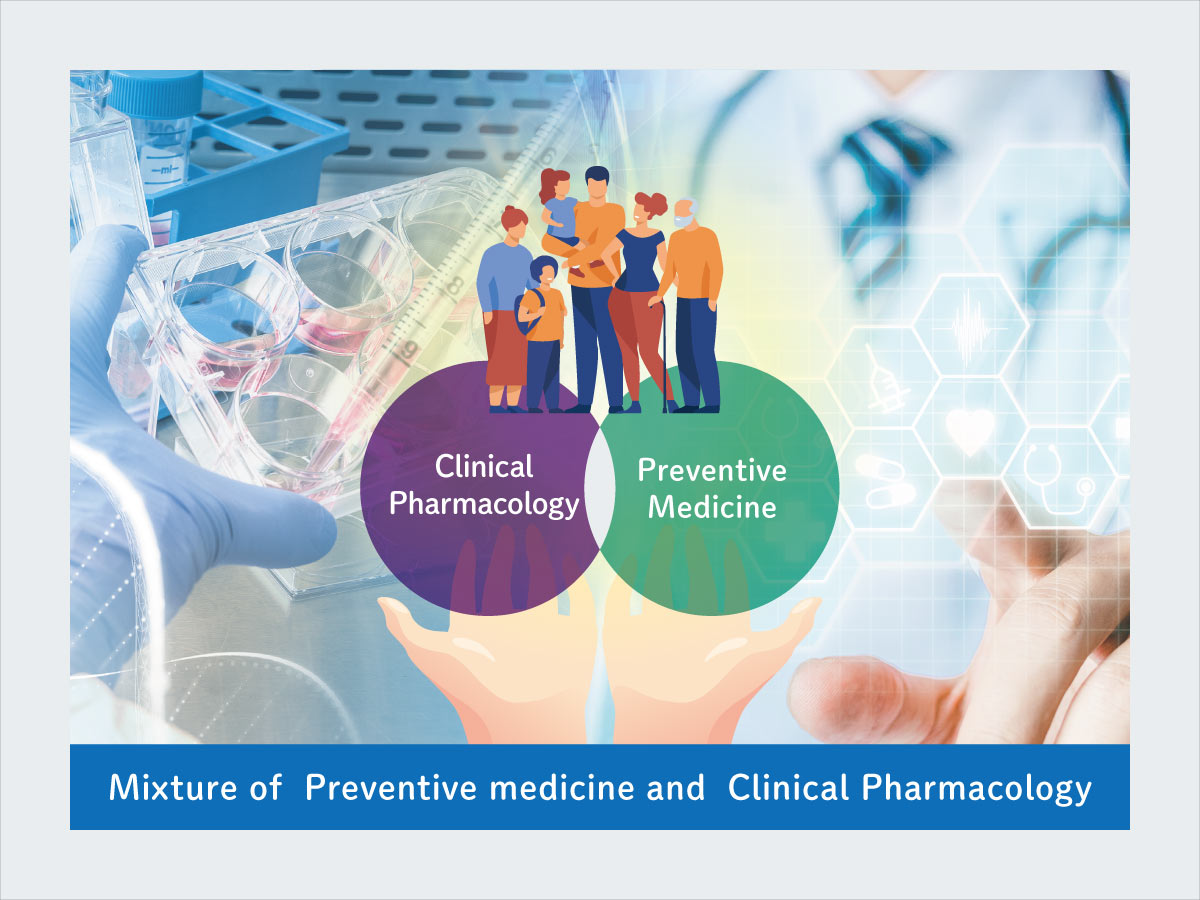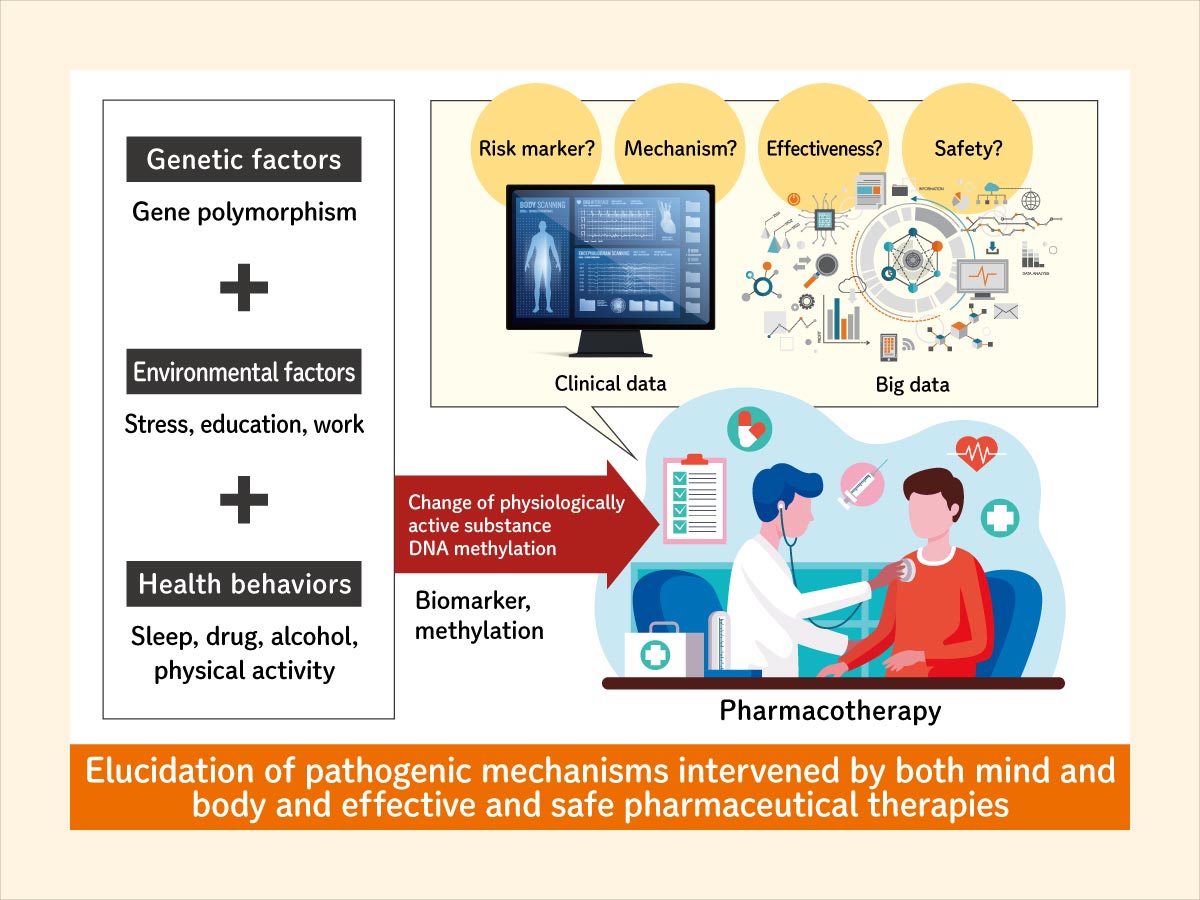Interdisciplinary basic-clinical research to explore evidence that allows better pharmaceutical therapy to society
Research Fields
Epidemiology, medical pharmacy, behavioral medicine, psychoneuroendocrine immunology
Keywords
Lifestyle-related disease, medical care coordination system, mental health, biomarker, clinical pharmacology
Research overview
Doing interdisciplinary basic-clinical research to deliver better pharmaceutical therapy to society Combination of preventive medicine and clinical pharmacology
I have engaged in research combining preventive medicine and clinical pharmacology to establish safer and more effective pharmaceutical therapies because I think that this combination will provide evidence to support the elucidation of pathological mechanism and discovery of new pharmacotherapies.
◆ Genetic/environmental factors + health behaviors + biomarkers
I have been consistently involved in study targeting biomarkers that change according to genetic and environmental factors and health behaviors. Complicated interactions between physical and mental health are involved in the development of disease or health of the human body. It is considered difficult to objectively evaluate stresses that may cause physical illness, and the studies are needed to clear the complicated interactions. Our recent studies have found that the urinary ratio of cortisone to cortisol, representing 11β-hydroxysteroid dehydrogenase activity, can be used as a stress marker. If such biomarkers are examined to identify association with the disease and the significance as risk markers, it is expected that a pathogenic mechanism through crosstalk between mind and body will be elucidated, new drugs will be discovered, and that the disease will be prevented from developing or becoming severe.
■ Establishment of pharmacotherapies that contribute to coping with disease
Since it is difficult to “be free from illness” as currently society continues to age, the establishment of pharmacotherapies that contribute to coping with disease in every-day life is becoming more significance, for example, “How should I deal with it once getting sick?” and “How should I prevent the disease from becoming severe?”
Reliable evidence is essential to provide effective and safe pharmaceutical therapies, the objective of our study. Specifically, I have used big data such as a large cohort study conducted at Saga University and the database of clinical adverse events. In the future, I want to work on research that will change the future of patients, using epidemiological techniques and collaborating with experts from various disciplines such as bioinformatics or pharmacometrics.
Message
Study to create reliable evidence is essential to provide effective and safe pharmaceutical therapies. I will devote myself to interdisciplinary and combined research including prevention and treatment and basics and clinical practice in order to deliver better pharmaceutical therapy to patients suffering from a disease(s).
Main publications
- Shimanoe, C., Matsumoto, A., Hara, M., ...Higaki, Y., Tanaka, K.Perceived stress, depressive symptoms, and cortisol-to-cortisone ratio in spot urine in 6878 older adults. Psychoneuroendocrinology, 2021, 125, 105125.
- Shimanoe, C., Hachiya, T., Hara, M., ...Naito, M., Wakai, K. A genome-wide association study of coping behaviors suggests FBXO45 is associated with emotional expression. Genes, Brain and Behavior, 2019, 18(2), e12481
- Shimanoe, C., Hara, M., Nishida, Y., ...Higaki, Y., Tanaka, K.Coping strategy and social support modify the association between perceived stress and C-reactive protein: a longitudinal study of healthy men and women. Stress, 2018, 21(3), 237–246
- Shimanoe, C., Hara, M., Nishida, Y., ...Higaki, Y., Tanaka, K.Perceived Stress, Depressive Symptoms, and Oxidative DNA Damage. Psychosomatic Medicine, 2018, 80(1), 28–33
- Matsumoto, A., Shimanoe, C., Tanaka, K., Ichiba, M., Hara, M.Development of suitable method for large-scale urinary glucocorticoid analysis by liquid chromatography–mass spectrometry. Journal of Chromatography B: Analytical Technologies in the Biomedical and Life Sciences, 2017, 1057, 62–69









